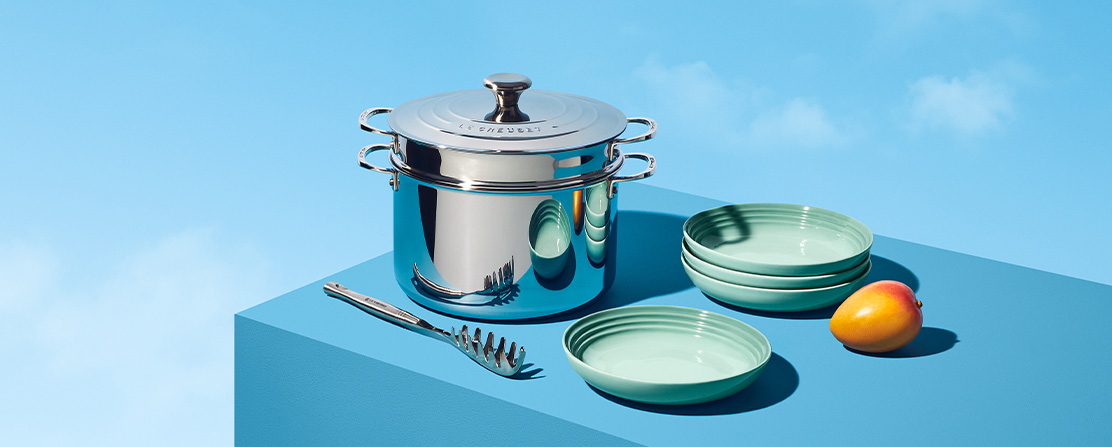
There are so many possibilities when it comes to pasta. It can be eaten in the summer through to winter, and some would even argue that its versatility make it so it can be eaten day after day without getting bored. Making your own pasta (from scratch) can be a fun family activity and can help you feel like you’ve taken an international vacation. Learn the steps to make your first homemade pasta dish with the help of pasta-specialist Meryl Feinstein of @PastaSocialClub.
Getting Started
The beauty of homemade pasta is in the simplicity of the ingredients – and in this case in the tools you need.

Ingredients
Simple, quality ingredients can be transformed in a craving-fulfilling meal with just a few steps. In the case of this recipe, the pasta comes together with two simple ingredients – semolina and water. Once you master this dough, you can also try experimenting with egg-based doughs or flavoured dough like spinach or tomato.
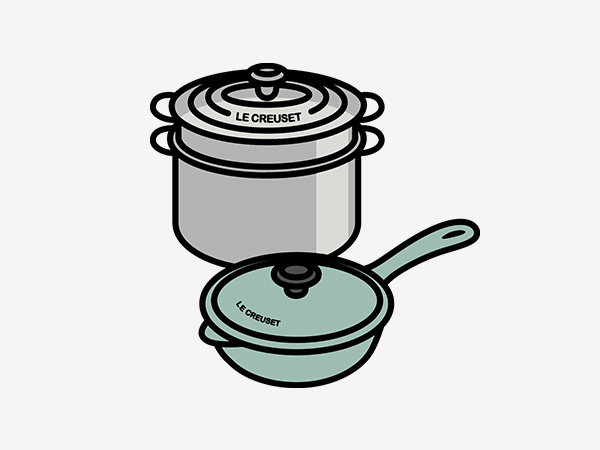
Le Creuset Tools
Cooking pasta is arguably the most important step to ensuring the dish has just the right texture. A large stockpot like this 8.3 L Stockpot with Pasta Insert is perfect for cooking fresh pasta. It ensures that water keeps boiling even after dropping in the noodles and prevents them from sticking to one another. Plus, the built-in colander means you can quickly pull them out when cooked al dente.
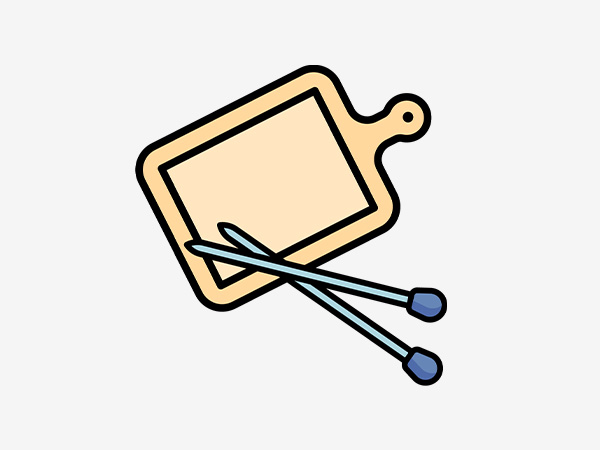
Pasta Tools
This recipe is especially fun to make with children or friends, as you don’t need any special equipment! All you need is a smooth surface and a wooden cutting board as well as a knitting needle or metal skewer.
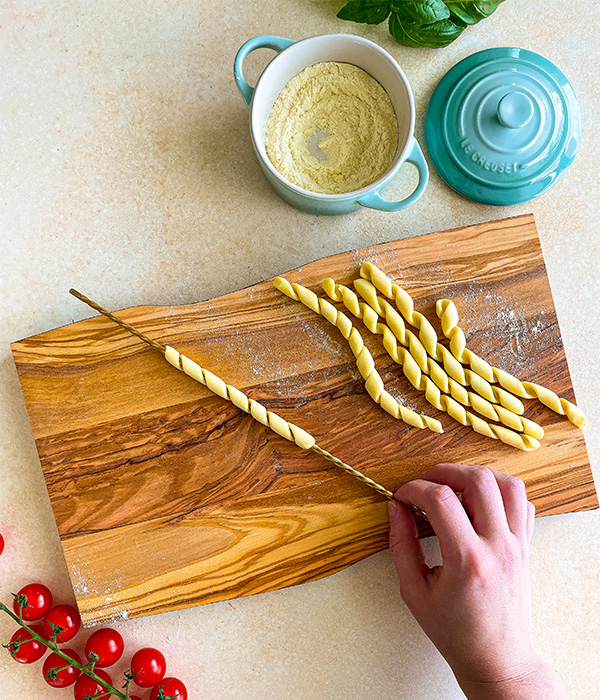
About this shape
Busiate—delightfully chewy, telephone-cord-like pasta spirals—are widely considered one of Sicily’s oldest handmade shapes. They’re made simply by coiling ropes of dough around a thin rod, which for centuries was a local reed called a ‘busa,’ and is now usually a metal spoke known as a ‘ferro’ or ‘ferretto.’ But you don’t need any special tools to make this beginner-friendly pasta: a wooden skewer or knitting needle from your local crafts store make for equally beautiful busiate.
Busiate are often served with pesto alla trapanese, a fresh tomato- and almond-based sauce from Trapani; here, they’re tossed pasta-salad-style with sweet and colorful bell peppers, tomatoes, and plenty of herbs. The sauce is inspired by peperonata, a staple dish from Italy’s south that’s a true celebration of summer’s bounty—don’t hesitate to make extra for topping crusty bread, polenta, or eating by the spoonful.
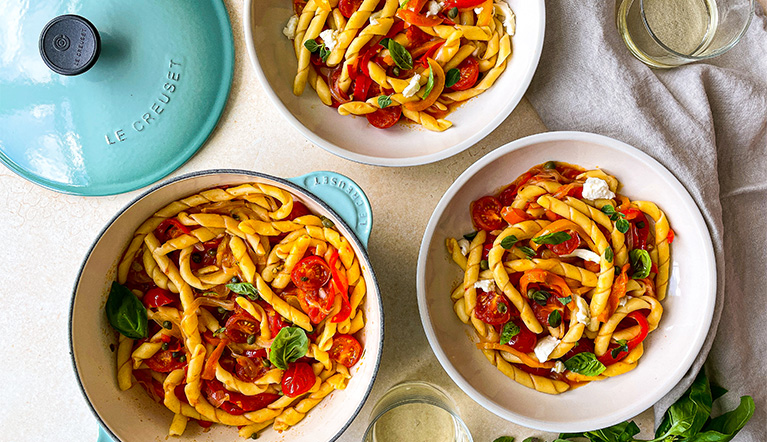
The Recipe
For the pasta
- 400 grams (2⅓ cups) semola rimacinata or semolina flour
- 200 ml (¾ cup plus 4 teaspoons) warm or tepid water
- Semolina flour, for dusting
For the sauce
- ¼ cup (60 ml) extra-virgin olive oil, plus more for serving
- 4 garlic cloves, thinly sliced
- 1 small red or yellow onion, peeled and thinly sliced into half moons
- 4 medium bell peppers (preferably a mix of red, yellow, and orange), stemmed, seeded, and sliced into thin strips
- Kosher salt
- 1 lb (2 cups; 454 grams) small sweet tomatoes like cherry or Campari, halved and divided
- ¼ cup (40 grams) capers in brine, drained
- 1 sprig fresh oregano, plus more for serving
- 2 sprigs fresh basil, plus more for serving
- 1 to 2 tablespoons (15 to 30 ml) red or white wine vinegar
- 8 ounces (225 grams) fresh mozzarella, torn into bite-sized pieces
For the pasta
- Make the pasta dough by hand (see instructions for the “well method” here) and knead it vigorously until smooth and firm, about 10 minutes. Alternatively, add the flour and water to a food processor fitted with the steel blade. Pulse until the ingredients are evenly distributed and couscous-like beads of dough form (the mixture should come together easily when pressed). Transfer the dough to a work surface and knead until the dough is smooth and springs back to a light touch, about 5 minutes.
- Wrap the dough tightly in plastic wrap and allow it to rest at room temperature for 30 minutes.
- Dust a sheet pan with semolina flour or line it with a dry dishcloth and keep it nearby. Cut off a quarter of the dough and re-wrap the remainder.
- On a clean wooden board (a cutting board works great), flatten the dough with the palm of your hand into a rough oval. With a rolling pin (or wine bottle!), roll the dough into a ¼-inch (½ cm)-thick slab, about the thickness of pita bread.
- Use a bench scraper or sharp knife to slice the dough into strips a little thinner than ½-inch (1¼-cm) wide.
- Position one of the strips horizontally on your work surface and cover the other pieces with a dish cloth. Pinch the sides of the strip upward so it’s more cylindrical. Then, starting in the center, use your fingers to roll the strip of dough into a thin strand—first back and forth, until the surface is smooth, and then outward in opposite directions, eventually making your way towards the ends. The goal is a strand that’s about 4mm thick, or similar to an udon noodle. Repeat with the remaining strips.
- Cut the strands of dough into pieces that are a little shorter than the length of your skewer/knitting needle of choice, anywhere from 5 to 8 inches (13 to 20 cm).
- Position a piece of dough vertically on your work surface. Place the skewer at a 45-degree angle toward the left-hand side so you have an upside-down V.
- Holding the bottom of the skewer loosely in place with your left hand, use your right hand to roll the other end—where the dough and skewer meet—toward you as if tracing an arc. The pasta will naturally wrap around the skewer like a telephone cord. (You can also manually wrap the dough in tight ringlets around the skewer.)
- Once the dough is completely twisted, position the skewer horizontally on your work surface. Gently roll it, with the pasta still attached, back and forth once or twice to flatten the dough. Twist the skewer to loosen the pasta and slide it off.
- Arrange the finished busiate in a single layer on the prepared sheet pan. Repeat with the remaining pieces, and then the remaining dough. If you have the time, let the pasta dry for an hour (or up to 5 hours) before cooking.
For the sauce
- In a Dutch oven, warm the oil over medium heat. Add the garlic and cook, stirring frequently, until fragrant and tinged gold around the edges, 2 to 3 minutes. Stir in the onion and peppers and season with salt. Cook, stirring occasionally, until softened, 8 to 10 minutes.
- Reduce the heat to medium-low. Stir in half of the tomatoes, the capers, the herbs, ½ cup (120 ml) water, and another pinch of salt. Partially cover and cook, stirring occasionally, until everything is soft and saucy, 30 to 40 minutes.
- While the peppers cook, add the rest of the tomatoes to a bowl and season with salt. Stir to combine and set aside to marinate. When the peppers are done, turn off the heat. Drain off any liquid from the salted tomatoes and add them to the pepper mixture. Discard the herb sprigs. Add the vinegar and season to taste. The sauce can be made up to 3 days ahead and refrigerated in an air-tight container.
- To serve
- Bring a large pot of water to a boil, then season it generously with kosher salt. Add the busiate, stir for a few moments, and cook until tender or to your liking, 3 to 5 minutes.
- Return the sauce to medium heat. Using a spider sieve or stockpot pasta insert, transfer the pasta directly from the pot to the sauce (if you need to drain the pasta in a colander, reserve some cooking water). Stir gently to combine, loosening with pasta water as needed, and serve warm or at room temperature, finished with more fresh herbs, a drizzle of olive oil, and the torn mozzarella.
Our best pasta tips
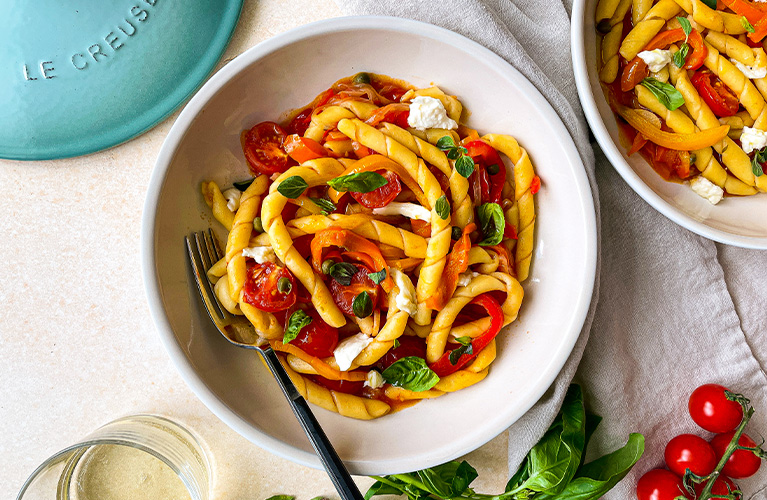
01.
Use a pasta fork
Using a spoon with these longer noodles can easily result in messy splatters and less than appealing plating. In order to preserve the shape of the pasta you created and to serve without a mess, use a Revolution® Pasta Fork that will cling on to the pasta.
02.
Al dente
Nothing is worst than overcooked pasta, especially when you’ve gone through the efforts of hand making the dough and rolling them out into individual noodles. Fresh pasta, unlike its store-bought dried equivalent cook incredibly quickly. It should be cooked through in 3-5 minutes.
03.
Plan for leftovers
We’re confident that you and any guests will have a hard time having just one plate which is why planning for leftovers or seconds is such an important tip. If you have extra helpers, double the dough recipe and freeze the extra pasta to have it on hand for extra special weeknight meals. Use a Large Sheet Pan to freeze them and the transfer to freezer bags. Just drop them frozen into boiling water when needed!
